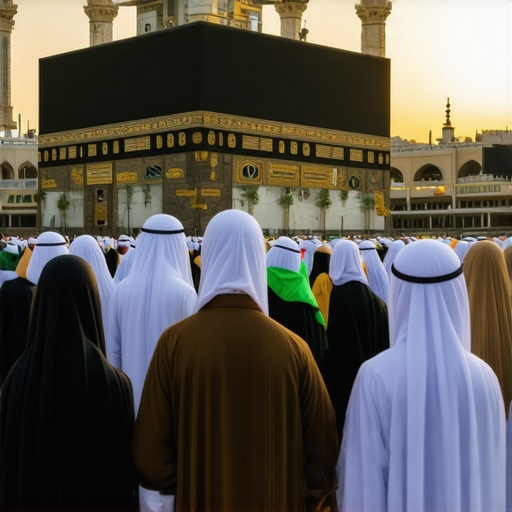My Personal Journey into Dream Interpretation and Sacred Symbols
As someone deeply fascinated by Islamic dream symbolism, I remember the first time I encountered the phrase ‘Muntakhab al Kalam fi Tafsir el Ahlam’. It was during a quiet evening, when I was exploring traditional dream dictionaries online. I was eager to understand the profound meanings behind my own dreams and how they connect to divine messages. That curiosity led me on a journey into sacred Islamic dream interpretation, which I now realize is a nuanced art rooted in centuries of spiritual wisdom.
Understanding the Core of ‘Muntakhab al Kalam fi Tafsir el Ahlam’
This phrase translates roughly to ‘Selected Words in Dream Interpretation’. It’s a sacred guide that helps decipher dreams through the lens of Islamic teachings. Personally, I found that focusing on this sacred text opened new avenues for understanding symbols such as snakes, animals, or even colors in my dreams. The process of interpreting dreams, I learned, is not just about uncovering hidden messages but also about aligning oneself with divine guidance.
How Sacred Symbols Shape Our Spiritual Insights
In my experience, recognizing symbols like the loss of teeth or the snake in dreams has profound spiritual significance. These symbols often point to crucial life lessons or divine warnings. I recall a vivid dream where I saw a snake, which initially startled me. However, after consulting authoritative sources and reflecting deeply, I realized it symbolized spiritual transformation and protection. Such insights reaffirmed the importance of understanding sacred dream symbols in Islam.
Why Do Dreams Hold Sacred Significance in Islam?
Dreams in Islam are considered a form of divine communication, especially when interpreted correctly. My own experiences have shown that dreams can serve as messages from Allah, guiding us through life’s challenges. For instance, dreaming of the Kaaba often symbolizes spiritual closeness and divine favor. Understanding the meaning of the Muntakhab al Kalam fi Tafsir el Ahlam helps believers decipher these sacred messages accurately.
What are the key principles to accurately interpret dreams in Islam?
Based on my readings and reflections, the principles involve sincerity, patience, and seeking knowledge from authentic sources. I highly recommend exploring the teachings of Ibn Sirin, a renowned scholar in Islamic dream interpretation, whose insights continue to guide many believers today.
If you’re curious about your own dreams and want to understand their divine significance, I encourage you to share your experiences in the comments or reach out through our contact page. Exploring these sacred symbols can unlock profound spiritual growth and divine wisdom.
Unlocking the Mysteries of Sacred Symbols in Islamic Dreams
Dreams have always held a special place in Islamic spirituality, serving as potential channels for divine messages and guidance. As an experienced student of sacred dream symbolism, I’ve learned that understanding these symbols requires both knowledge and intuition. For instance, encountering a loss of teeth in a dream often symbolizes significant life changes or spiritual warnings, while a snake may represent hidden dangers or spiritual transformation. Recognizing these symbols can deepen our understanding of divine messages, guiding us toward personal and spiritual growth.
How Do Sacred Symbols Reflect Divine Guidance?
In Islamic dream interpretation, symbols are not arbitrary; they are sacred signs that encode divine wisdom. For example, dreaming of the Kaaba signifies closeness to Allah and spiritual purification. Similarly, colors like black can symbolize divine power or mystery, depending on context. Deciphering these symbols requires a nuanced understanding of their spiritual and cultural significance, which can be achieved through studying classical texts like Ibn Sirin’s interpretations.
What Are the Practical Steps to Interpret Sacred Symbols Accurately?
Accurate interpretation involves sincerity, patience, and reliance on authentic sources. I advise beginners to start by keeping a detailed dream journal, noting symbols and feelings, then cross-referencing with reputable Islamic dream dictionaries. Engaging with scholars or trusted online resources, such as principles of dream interpretation, can help refine your understanding. Remember, dreams may carry multiple layers of meaning—what appears as a warning might also be a call for spiritual reflection. As you grow in knowledge, your ability to discern divine guidance through symbols will deepen.
How Can Recognizing Sacred Symbols Enhance My Spiritual Journey?
By learning to recognize and interpret sacred symbols, you open a dialogue with the divine, gaining insights that can transform your spiritual practice. This awareness fosters humility and mindfulness, encouraging you to seek divine wisdom in everyday life. For example, seeing a prophet’s dream or a sacred mosque in your sleep can be profound. These symbols often serve as spiritual checkpoints, reminding us to stay connected to our faith and divine purpose. To deepen your understanding, I invite you to explore more about sacred Islamic dream messages and share your experiences in the comments or through contacting us. Your journey into sacred dream symbolism can unlock divine secrets and foster spiritual growth.
Exploring the Deeper Layers of Sacred Symbols in My Dream Journey
As I delved further into the realm of Islamic dream interpretation, I realized that each symbol carries not just a surface meaning but a layered spiritual message. For example, when I dreamt of a loss of teeth, it initially seemed alarming. However, reflecting on classical texts and my intuition revealed it was a sign of shedding old beliefs and embracing spiritual renewal. Such experiences taught me that understanding sacred symbols is a dynamic process, blending knowledge with inner wisdom, and often, divine timing.
The Nuance of Symbols and Their Personal Significance
One of the most profound realizations was how symbols like the Kaaba in dreams can symbolize our inner spiritual state. I once saw the Kaaba illuminated in a dream during a period of spiritual contemplation, and it reaffirmed my path towards closeness to Allah. Recognizing and interpreting these symbols require us to consider our personal circumstances, emotional states, and ongoing spiritual journeys. It’s a deeply personal dialogue with divine signs that can transform our understanding of life’s challenges and blessings.
How Do Sacred Symbols Guide Our Daily Spiritual Practices?
Integrating the understanding of dream symbols into daily life enhances our mindfulness and spiritual discipline. For instance, dreaming of black in dreams might symbolize divine power or mystery. Reflecting on such symbols can inspire us to seek deeper knowledge or patience in our spiritual pursuits. I began journaling my dreams meticulously, cross-referencing symbols with trusted sources like Ibn Sirin’s insights, and seeking guidance from knowledgeable scholars. This practice has enriched my spiritual life and helped me navigate life’s complexities with divine wisdom.
Can Sacred Symbols Serve as Personal Guides in Challenging Times?
Absolutely. I have found that dreams filled with symbols like loss of teeth or encounters with snakes often serve as divine warnings or encouragements. These symbols prompt us to reflect on our spiritual state and remind us that divine guidance is always present, especially when we are facing difficulties. I encourage everyone to keep a dream journal and seek authentic interpretations, as these signs can be powerful tools for spiritual resilience and growth.
Invitation for Personal Sharing and Deeper Exploration
If you’ve experienced meaningful dreams or symbols that resonated with your spiritual journey, I invite you to share your stories in the comments or contact us directly. Exploring these sacred messages together not only deepens our understanding but also nurtures a community rooted in faith and divine guidance. Remember, each symbol is a sacred key unlocking divine secrets, guiding us toward fulfillment of our spiritual purpose.
Unveiling the Mystical Language of Sacred Symbols in Islamic Dream Interpretation
As I continue to explore the profound realm of Islamic dream symbolism, I am continually struck by the layered complexity and divine intricacy embedded within these sacred signs. Each dream, whether it appears as a fleeting vision or an intense nocturnal experience, carries a unique message tailored to the individual’s spiritual journey. Delving deeper, I have come to realize that understanding these symbols requires not only knowledge of classical texts but also a refined intuitive sensitivity—an inner dialogue with divine guidance. This delicate balance between scholarly insight and spiritual intuition allows us to unlock the hidden messages Allah embeds within our dreams, offering us pathways to enlightenment and divine favor.
How Do Sacred Symbols Embody Divine Wisdom and Personal Transformation?
Sacred symbols such as the loss of teeth or the snake are not mere superficial images; they are divine allegories that encode profound spiritual lessons. For instance, a snake often signifies spiritual transformation, the shedding of old habits, or warning against hidden dangers. Such symbols serve as divine mirrors reflecting our inner state, urging us toward self-purification and higher consciousness. The classical perspective, reinforced by contemporary scholars like Ibn Sirin, emphasizes that these symbols are carefully crafted messages from Allah, guiding us through life’s complexities and spiritual tests. Recognizing and interpreting these signs can catalyze personal growth, guiding believers toward a more profound understanding of their divine purpose.
What Is the Role of Context and Personal Circumstances in Interpreting Sacred Dreams?
While classical texts provide essential frameworks, the personal context of the dreamer is vital in decoding sacred symbols accurately. For example, dreaming of the pregnancy may symbolize spiritual rebirth or new beginnings, but its precise meaning depends on the dreamer’s current life circumstances, emotional state, and spiritual goals. The depth of this interpretative process is akin to a sacred conversation, where the dreamer’s sincerity and self-awareness serve as crucial tools. By cultivating a mindful approach—keeping detailed dream journals, reflecting on personal feelings, and consulting authentic sources—we can align ourselves more closely with divine messages. This personalized method transforms dream interpretation from mere symbolism into a meaningful spiritual practice that nurtures divine connection.
How Can Advanced Dream Interpretation Techniques Enhance Our Connection with Divine Guidance?
Employing advanced techniques, such as cross-referencing classical interpretations like those found in the Ibn Sirin’s interpretations or engaging in spiritual reflection through prayer and supplication, can greatly enhance our grasp of divine messages. Additionally, understanding numerology and symbolism within the Quranic context deepens this connection, revealing layers of divine wisdom that transcend surface meanings. For instance, the number seven in dreams often symbolizes divine completion or sacredness, as emphasized in Islamic traditions. Incorporating these tools into our daily spiritual discipline allows us to perceive divine guidance more clearly and respond with humility and faith. I invite you to explore these advanced insights further and share your experiences—each dream holds a key to unlocking divine secrets, waiting for your attentive interpretation.
Remember, cultivating this sacred dialogue requires sincerity, patience, and ongoing learning. The more we immerse ourselves in authentic knowledge and spiritual practice, the more our dreams become a luminous bridge to Allah’s infinite wisdom. To deepen your understanding, I encourage you to engage with trusted sources and reflect on your personal dreams. Share your insights and questions in the comments or contact us directly—together, we can navigate the sacred language of dreams and uncover divine truths that elevate our spiritual journey.
The Dynamic Interplay of Symbols and Divine Messages in Personal Spiritual Growth
Each sacred symbol in dreams is like a divine whisper, gently guiding us toward self-awareness and spiritual maturity. For example, encountering the Kaaba signifies divine proximity and spiritual purification, urging believers to renew their faith and seek Allah’s favor. Recognizing these symbols within their personal context transforms dreams into active tools for spiritual refinement. This process involves ongoing reflection, prayer, and study—an intimate journey where divine signs become trusted companions on the path to enlightenment. As I have experienced, embracing this sacred dialogue enriches our life with divine wisdom, equipping us to face challenges with resilience and unwavering faith. I invite you to delve deeper into this sacred knowledge and share your journey—each symbol is a divine gift, unlocking secrets that lead to ultimate fulfillment and divine connection.
Things I Wish I Knew Earlier (or You Might Find Surprising)
Hidden Depths of Dream Symbols
When I first started exploring Islamic dream symbolism, I underestimated how layered and profound these symbols truly are. Discovering that a snake in a dream could mean transformation or warning rather than mere danger was a revelation that deepened my spiritual understanding.
The Power of Personal Context
Initially, I thought dream symbols had fixed meanings, but over time I realized their significance varies greatly depending on personal circumstances. Recognizing this helped me approach dream interpretation with humility and patience.
Dreams as Divine Messages
It took me a while to appreciate how dreams can serve as divine communication from Allah. Embracing this perspective transformed my nightly visions into opportunities for spiritual growth and reflection.
Integrating Symbols into Daily Life
Learning to interpret symbols like the Kaaba or colors like black has inspired me to incorporate mindfulness into daily routines, seeking divine guidance in both dreams and waking moments.
The Importance of Authentic Sources
My journey was enriched by studying classical texts and consulting reputable scholars. Trustworthy sources like Ibn Sirin’s interpretations provided clarity and rooted my understanding in tradition.
Resources I’ve Come to Trust Over Time
- Ibn Sirin’s Dream Interpretation: A timeless classic that offers foundational insights into Islamic dream symbolism, guiding me through complex symbols with clarity.
- Al-Nabulsi’s Works: Deeply rooted in Islamic tradition, his interpretations helped me connect symbols to spiritual lessons.
- Online Islamic Dream Dictionaries: Practical for daily use, these resources complement classical texts and aid in quick references.
- Scholarly Articles and Lectures: Listening to scholars’ discussions has expanded my understanding and offered new perspectives.
Parting Thoughts from My Perspective
Exploring sacred symbols in Islamic dream interpretation has been a transformative experience, enriching my spiritual connection and understanding of divine messages. I believe that dreams are a sacred language from Allah, filled with symbols that guide us toward self-awareness and spiritual growth. By approaching dream interpretation with sincerity, patience, and reliance on authentic sources, we open ourselves to divine wisdom that can illuminate our paths. If this resonates with you, I’d love to hear your thoughts or stories. Sharing our experiences not only deepens our understanding but also strengthens our faith. Feel free to comment below or reach out through our contact page—let’s continue this sacred journey together.


